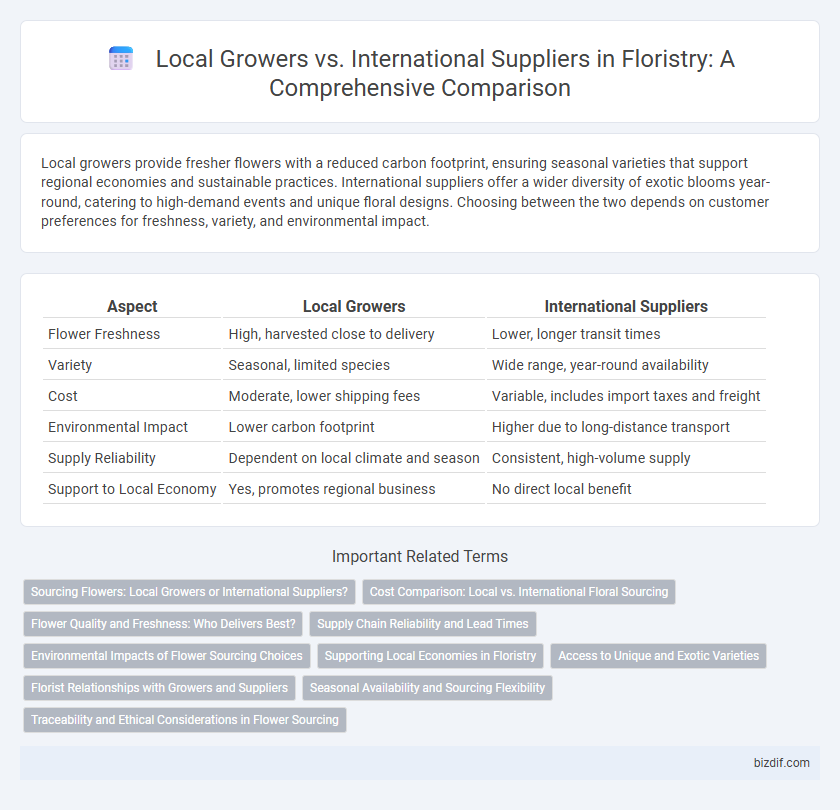Local growers provide fresher flowers with a reduced carbon footprint, ensuring seasonal varieties that support regional economies and sustainable practices. International suppliers offer a wider diversity of exotic blooms year-round, catering to high-demand events and unique floral designs. Choosing between the two depends on customer preferences for freshness, variety, and environmental impact.
Table of Comparison
| Aspect | Local Growers | International Suppliers |
|---|---|---|
| Flower Freshness | High, harvested close to delivery | Lower, longer transit times |
| Variety | Seasonal, limited species | Wide range, year-round availability |
| Cost | Moderate, lower shipping fees | Variable, includes import taxes and freight |
| Environmental Impact | Lower carbon footprint | Higher due to long-distance transport |
| Supply Reliability | Dependent on local climate and season | Consistent, high-volume supply |
| Support to Local Economy | Yes, promotes regional business | No direct local benefit |
Sourcing Flowers: Local Growers or International Suppliers?
Sourcing flowers from local growers ensures fresher blooms with a smaller carbon footprint, supporting regional economies and seasonal variety. International suppliers offer a wider selection of exotic flowers year-round, often at competitive prices due to large-scale production. Choosing between local and international sources depends on priorities like sustainability, flower diversity, and budget constraints in floristry.
Cost Comparison: Local vs. International Floral Sourcing
Local floral sourcing often results in lower transportation costs and fresher blooms, reducing overall expenses despite typically higher per-unit prices from local growers. International suppliers offer bulk purchasing discounts and a wider variety of exotic flowers, but incur significant shipping fees, import taxes, and potential spoilage costs that can inflate the total budget. Evaluating the cost comparison requires balancing the premium on freshness and sustainability from local growers against the volume savings and diversity provided by international suppliers.
Flower Quality and Freshness: Who Delivers Best?
Local growers typically provide flowers with superior freshness and quality due to shorter transport times and immediate harvesting, ensuring vibrant colors and longer vase life. International suppliers may offer a wider variety of exotic blooms but often face challenges in maintaining peak freshness because of extended shipping durations and customs delays. Evaluating flower quality often favors local sources for daily floristry needs, while international suppliers serve niche markets requiring unique or off-season varieties.
Supply Chain Reliability and Lead Times
Local growers provide more reliable supply chains with shorter lead times, ensuring fresher flowers and quicker replenishment for florists. International suppliers often face longer transit times and potential delays due to customs and logistical complexities, risking product freshness and schedule consistency. Prioritizing local sources enhances supply chain resilience and supports timely inventory management in the floristry industry.
Environmental Impacts of Flower Sourcing Choices
Local growers reduce carbon emissions significantly by minimizing transportation distances compared to international suppliers who often rely on air and long-haul shipping. Sourcing flowers locally supports sustainable farming practices and reduces the need for preservatives and refrigeration, lowering energy consumption. International suppliers contribute to higher environmental footprints through packaging waste and increased pesticide use to maintain flower durability during extended transit.
Supporting Local Economies in Floristry
Choosing local growers in floristry promotes sustainable practices and strengthens regional economies by circulating revenue within the community. Local sourcing reduces carbon footprints through minimized transportation distances while ensuring fresher, higher-quality blooms for customers. Supporting local florists and growers fosters job creation and preserves regional floral varieties, enhancing the industry's cultural and economic resilience.
Access to Unique and Exotic Varieties
Local growers offer access to seasonal, region-specific flowers that reflect the unique climate and soil conditions, ensuring fresher and more sustainable options for florists. International suppliers provide a diverse range of exotic varieties not native to local regions, expanding creative possibilities and meeting high-demand trends in luxury floral design. Combining local and global sources enhances variety, allowing florists to tailor arrangements with both rare blooms and fresh, locally grown flowers.
Florist Relationships with Growers and Suppliers
Florists benefit from strong relationships with local growers who provide fresher, seasonal flowers and support sustainable practices. International suppliers offer a wider variety of exotic and off-season blooms, ensuring supply consistency and competitive pricing. Balancing both local and international sources enhances floral design options and meets diverse customer demands.
Seasonal Availability and Sourcing Flexibility
Local growers offer fresher blooms with peak seasonal availability, ensuring flowers are harvested at optimal times for color and fragrance. International suppliers provide greater sourcing flexibility, allowing access to exotic varieties year-round despite potential delays and varying quality due to transportation. Combining both sources enhances inventory diversity while balancing freshness and variety for florists.
Traceability and Ethical Considerations in Flower Sourcing
Local growers ensure greater traceability in flower sourcing by providing transparent information on cultivation practices and supply chains, allowing consumers to verify ethical standards directly. International suppliers often face challenges in maintaining consistent ethical oversight due to complex logistics and diverse regulatory environments, increasing the risk of labor exploitation and environmental harm. Prioritizing local sourcing supports sustainable floristry by reducing carbon footprints, promoting fair labor conditions, and fostering regional economies.
Local growers vs International suppliers Infographic

 bizdif.com
bizdif.com